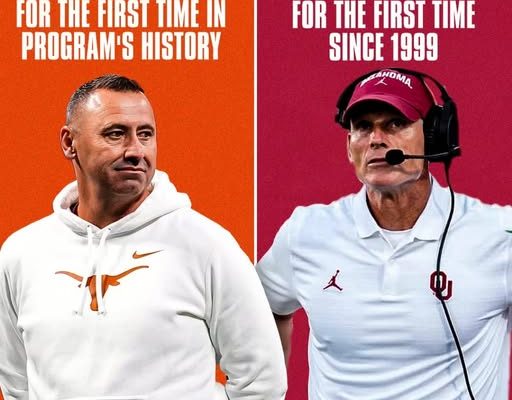The preseason poll for the upcoming college football season has sent shockwaves through the fan bases of two of the sport’s most storied programs — the Texas Longhorns and the Oklahoma Sooners — with the gap between them proving to be not just noticeable, but downright massive. While both teams will enter the new campaign with rich histories, passionate fan support, and high expectations, the numbers released by the pollsters show a separation that few would have expected, especially given the heated rivalry and the historical parity between these programs. Texas has roared into the preseason rankings as a legitimate national contender, earning a lofty position among the nation’s top teams. Oklahoma, meanwhile, has found itself much farther down the list, a gap wide enough that it has become one of the most talked-about storylines in Big 12 and college football circles as a whole. This isn’t simply about one team being ranked higher than the other — that happens often in preseason polls — but rather about the sheer size of the chasm, which speaks volumes about perception, recruiting, returning talent, and recent momentum. The gap is not just about points or votes in a poll; it’s about how the college football world currently views the programs’ trajectories. Texas, coming off a season where they met or exceeded expectations, is seen as a team with an elite quarterback, deep skill positions, and a battle-tested coaching staff that has started to win the games that matter most. Their recruiting classes have been stacked, player development has shown tangible progress, and their performance in high-profile matchups has elevated their national credibility. In short, they look the part of a contender on the rise, ready to make noise not just in their conference but in the playoff race. Oklahoma, on the other hand, is still wrestling with an identity crisis under a newer coaching regime that has yet to fully stabilize the program’s trajectory after Lincoln Riley’s departure. While they have pockets of elite talent and the type of tradition that should attract top recruits, their on-field results in recent seasons have been inconsistent. Close losses, defensive lapses, and struggles against ranked opponents have left poll voters hesitant to project them as immediate contenders. Instead, they are viewed more as a team in the middle of a rebuild — talented, but still unproven. What makes this particularly shocking to many fans is the historical context. The Red River Rivalry has often been a showcase of two evenly matched powerhouses, with the winner frequently going on to capture conference titles or make serious postseason runs. Seeing such a wide gap in preseason perception feels foreign to those used to the annual narrative of Texas and Oklahoma as equals on the battlefield. This year, the narrative has shifted, with Texas being treated like the heavyweight favorite and Oklahoma more like the scrappy underdog trying to reclaim its footing. Much of the disparity in the poll comes down to quarterback play and returning production. Texas returns an established leader at quarterback who has already proven himself against elite defenses and has the benefit of continuity in the offensive system. Their receiving corps is stacked with NFL-caliber talent, and their offensive line is projected to be among the best in the nation. On defense, they bring back experienced starters at key positions, bolstered by a strong influx of young talent from recent recruiting classes. Oklahoma’s quarterback situation, while promising, is less settled in the eyes of the national media. Their skill positions have talent, but the depth and proven production are not as clear-cut. Defensively, while there have been improvements in recruiting and schemes, last season’s lapses in critical moments have left lingering doubts about their ability to consistently stop high-powered offenses. The pollsters seem to be factoring in not just last season’s records, but also how each program fared against the toughest opponents on their schedule. Texas had signature wins that proved they could handle big-game pressure, while Oklahoma stumbled in several high-profile moments that would have shifted the narrative in their favor. The perception gap is also influenced by recruiting momentum. Texas has been on a tear in securing top-tier recruits, particularly in skill positions and the trenches. They’ve been winning battles not only against Big 12 foes but also against national bluebloods, further fueling the belief that their roster is built for sustained success. Oklahoma has had strong recruiting classes as well, but the shine has dimmed slightly due to key decommitments and the challenge of convincing recruits that they are on the brink of championship contention. The size of the gap in the poll is not without its critics. Oklahoma fans and some analysts argue that preseason rankings often rely too heavily on hype and fail to account for the unpredictable nature of rivalry games and conference play. They point out that the Sooners have often thrived in seasons where they were underestimated, using the perceived disrespect as fuel to overachieve. They also note that Texas has occasionally fallen short of lofty preseason expectations in the past, making the gap more about perception than an absolute reflection of on-field superiority. Still, perception matters in college football, especially in the era of the College Football Playoff. A higher preseason ranking not only boosts a team’s visibility but can also shape the narrative in ways that affect mid-season and end-of-season evaluations by the playoff committee. Texas enters the season with a cushion of goodwill and belief from the national media, while Oklahoma will have to claw its way into the conversation from a much lower starting point. The gap could, of course, shrink rapidly once the season begins. One upset or surprise loss for Texas could see them tumble, while a statement win for Oklahoma in the early weeks could change the tone entirely. And, as always, the Red River Rivalry looms as the ultimate equalizer — one game in which rankings, hype, and polls often go out the window. A strong showing by Oklahoma in that matchup could flip the narrative in an instant. For now, though, the preseason poll stands as a symbolic line in the sand, highlighting how differently these two programs are viewed entering the new season. It’s a reminder that college football is as much about perception and momentum as it is about actual wins and losses. Texas has earned the benefit of the doubt through consistent improvement, strong recruiting, and marquee victories. Oklahoma, while still dangerous and respected, is seen as needing to prove itself all over again before being welcomed back into the top-tier conversation. In a sport fueled by rivalries, pride, and bragging rights, this gap adds yet another layer of intrigue to an already heated Texas-Oklahoma dynamic. The Longhorns will look to justify their lofty status, while the Sooners aim to turn perceived disrespect into motivation. If history has taught us anything, it’s that the gap on paper in August rarely matches the gap on the scoreboard in October. But until the games are played, this preseason gulf will remain a talking point that fans, players, and coaches alike cannot ignore, setting the stage for one of the most anticipated showdowns of the year.
The gap between the Texas Longhorns and the Oklahoma Sooners in the preseason poll is HUGE



